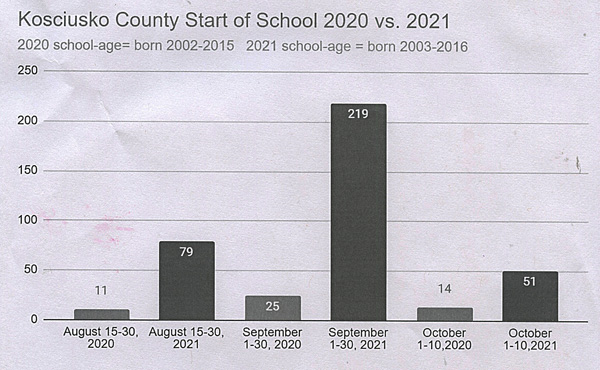
Though Kosciusko County remained at the “orange” advisory level Wednesday, with the COVID-19 numbers “softening,” Warsaw Mayor Joe Thallemer indicated the weekly and/or biweekly press conferences were on hold going forward.
At least for now.
The press conferences also had ended over the summer, after vaccinations became available and numbers began dropping, only to return when the delta variant caused a spike in the number of people with the virus, hospitalizations and deaths.
The advisory level refers to the current guidelines from the Indiana Department of Health the state’s counties must follow. Blue is the lowest, followed by yellow, orange and red at the highest. It is scored based on weekly cases per 100,000 residents and the seven-day all tests positivity rate. Kosciusko County’s was 2.5 (orange) on Wednesday.
Kosciusko County Public Health Officer Dr. William Remington said, “We report the softening of cases in Kosciusko County and across the state. Across the country, actually, which is good.”
The county crossed the 12,000 cases threshold on Tuesday, he said. The first known Kosciusko County case was March 26, 2020.
There have been seven additional deaths since Sept. 29, putting the county at 146 deaths. Remington said he imagined that by the end of the month, there would be a softening of the number of new deaths per week.
Remington said the county’s positivity rate is down to 10.9% from 11.8% Sept. 29. The county is at 294 weekly cases per 100,000, down from 342 two weeks ago. The Center for Disease Control and Prevention defines high community transmission at greater than 100 weekly cases per 100,000.
Indiana hospitalizations continue to decline, he said, with the state at 1,729, down from 2,113 two weeks ago. The seven-day moving average for Indiana deaths is 17, down from 25 two weeks ago.
As for vaccinations, Remington said there’s been a “very mild uptick” in doses, both at the county and state levels. The county is at 44% immunization rate for those age eligible.
“There is continued high community transmission, albeit a little softer,” he said. “There is still high disease burden. Still a number of hospitalizations, though it’s softer than two weeks ago.”
Remington said a layered mitigation should continue with masking, social distancing and immunizations.
Over the last few weeks, the CDC spotlighted some of the reports on the pediatric influence of the delta variant through late summer.
“It’s really striking. We certainly felt it here,” Remington said.
He provided a graphic, put together by the county’s communicable disease nurse, Teresa Reed, to show “our Kosciusko County cases that are school-age. This start of school compared to last start of school. It really is striking, reflecting, again, the reports from the CDC and others that this delta strain really stirred up pediatric cases. Not just cases, but pediatric admissions. And that folded into the matrix of our thinking in early September, particularly with back-to-school guidance,” Remington said.
The graphic, which compares the Kosciusko County 2020 school-age cases (born 2002-2015) to the 2021 school-age cases (born 2003-2016), shows that the number of cases from Aug. 15-30, 2020, totaled 11 while the cases from Aug. 15-30, 2021, totaled 79. There were 25 cases Sept. 1-30, 2020, while there were 219 cases Sept. 1-30, 2021. And in Oct. 1-10, 2020, there were 14 cases, compared to 51 cases Oct. 1-10, 2021.
Remington said, like the general cases, the pediatric cases and admissions are softening quickly in late September and early October.
“Just to say, that experience late August and through September was very sobering to public health thinkers like me. That cavalier approach toward the kids particularly was kind of – we were set back on our heels a bit with that observation. Just as the school doors were opening this year,” he said.
Bowen Center President and CEO Kurt Carlson said for the last few weeks, the free testing site at the Shrine building at the fairgrounds hovered around 100 people a day, with Mondays and Tuesdays being the busiest days and Saturdays the least busy. He said about 23% of those getting tested are under 20 years old. The Hispanic population accounts for around 6%, down from the peak. People who are symptomatic account for about 65%, which is up a little bit. Those testing positive are 17%.
The testing site is open 9 a.m. to 3 p.m. Monday, Wednesday, Thursday and Friday; noon to 6 p.m. Tuesday; and 10 a.m. to 2 p.m. Saturday. The hotline number is 574-347-4256, but Carlson said it’s getting very few calls.
According to a Washington Post article on Wednesday, “Doctors in the United States are bracing for a ‘twindemic’ of flu and coronavirus spikes. … In countries with relatively high vaccination rates such as the United States and in Europe, it could get tricky for the immunized to tell a nasty cold from a breakthrough case of COVID-19. It’s also hard to predict how bad this flu season will be after last year’s historically low flu rates during lockdowns. With children back in school in many parts of the world and travel picking up in tourist spots, health-care professionals worry that the flu season could come roaring back and are urging people to get their shots.”
Remington said the flu season this year will probably be more severe than last year, which was “so quiet. Oddly quiet. But I don’t believe the experience of the southern hemisphere has reflected that it was really a terrible year. I haven’t heard that anywhere. It was a mild year in Australia, for instance. Looking at the Australia experience is always kind of telling to public health thinkers in this country.”
Australia has winter when the U.S. has summer.
“It’s a great time to get a flu shot. So please do that,” Remington said. “It’ll just make this so much easier to think through. The more we’re immunized – the more we’re immunized against COVID, more immunized against influenza, the less people with high fevers, cough, feeling horrible, can’t get out of bed.”
While no vaccine is perfect, he said, at least it decreases the burden and “we’re all ready for that.”




